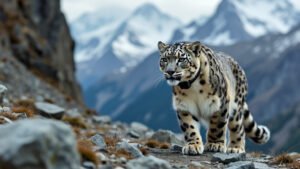Introduction
Research stations play a crucial role in the conservation of snow leopards by monitoring their populations, protecting habitats, and preventing poaching
These stations, often located in remote, high-altitude regions, provide valuable data about snow leopards’ health, movement patterns, and interactions with the environment. By leveraging technologies like camera traps and GPS collars, scientists at these stations can track and study snow leopards more effectively
This article will explore how research stations contribute to snow leopard conservation through various means such as habitat protection, anti-poaching efforts, and climate change research
The Importance of Research Stations in Monitoring Snow Leopards
Research stations in snow leopard habitats are essential for understanding these elusive predators, often found in remote, rugged regions like the Himalayas, Altai, and Tien Shan mountains. Due to the snow leopard’s cryptic nature and the harsh environment in which they live, traditional monitoring methods are insufficient
Research stations fill this gap by establishing long-term bases for field studies, which are crucial to understanding snow leopard behavior, population health, and the threats they face
These stations serve as hubs for scientists to gather data, track the movements of individual snow leopards, and assess their health through cutting-edge technologies, ultimately enabling conservationists to implement more effective strategies to protect this endangered species
How Snow Leopards Are Tracked in Remote Regions
Research stations rely on advanced technology to track snow leopards in their mountainous, hard-to-reach environments. GPS collars are among the most important tools, allowing researchers to monitor snow leopard movements in real time across vast distances
These collars transmit data on the animal’s location, activity, and sometimes even physiological health. For instance, a study conducted by McCarthy et al. (2017) in Mongolia used GPS collars to track snow leopards across 1,000 square miles, uncovering critical information about their range and movement patterns
This tracking data helps researchers understand migration routes, territorial behaviors, and hunting habits, which are vital for making informed conservation decisions
Besides GPS collars, camera traps play a major role in monitoring. These motion-activated cameras are placed strategically around snow leopard territories, capturing images of the cats as they move through the area
In a 2020 study published in Journal of Wildlife Management, researchers placed 400 camera traps across the Himalayas, capturing over 1,000 images of snow leopards. These images not only confirm the presence of the species but also help identify individual animals through their unique fur patterns
The Role of Camera Traps and GPS Collars
Camera traps and GPS collars are complementary tools used in conjunction by research stations to offer a more comprehensive understanding of snow leopard ecology. Camera traps excel at identifying individual animals and monitoring population trends, especially in regions where capturing and collaring snow leopards is challenging due to terrain
However, while camera traps can confirm the presence of snow leopards and provide a snapshot of activity, they are limited in terms of tracking movement over time
GPS collars, on the other hand, provide continuous tracking data, which is essential for studying snow leopard ranges and how they interact with their environment. For example, a 2019 study in Conservation Biology revealed that snow leopards in the Tien Shan Mountains travel up to 25 miles a day in search of prey, often crossing international borders, making international conservation collaboration crucial
By using both tools together, research stations can gain a clearer picture of snow leopard behavior, movement, and population health, all of which are critical for successful conservation efforts
Monitoring Population Trends and Health
One of the key roles of research stations is to monitor long-term trends in snow leopard populations. Population studies allow conservationists to determine whether conservation measures are effective or if new threats are emerging
Through a combination of field observations, camera trap data, and GPS tracking, research stations can estimate population sizes and monitor the genetic diversity of the species, which is vital for maintaining a healthy population
In addition to population monitoring, research stations often perform health assessments on captured snow leopards. Veterinarians at these stations can examine the animals for signs of disease, malnutrition, or injury. The data gathered from these health checks informs researchers about the overall well-being of snow leopards in a given region and helps guide conservation strategies
For instance, an investigation into snow leopard health in Nepal revealed that the animals were increasingly suffering from diseases linked to human encroachment, such as canine distemper, indicating a need for more stringent habitat protection measures (Sharma et al., 2020)
The Role of Research Stations in Snow Leopard Habitat Protection
Snow leopard habitats are vast, rugged, and spread across multiple countries, making habitat protection a complex task. Research stations play a central role in identifying and preserving these critical habitats
They provide the scientific data necessary to understand snow leopards’ habitat needs and the environmental pressures they face, such as human encroachment, loss of prey species, and climate change
By studying snow leopard behavior and their interactions with the environment, research stations help conservationists identify the most important areas to protect and the best strategies for doing so
Preserving Critical Snow Leopard Habitats
Research stations are often located in key snow leopard habitats, where they carry out extensive fieldwork to study the species’ habitat use. These stations gather data on the types of terrain snow leopards prefer, such as rocky slopes and rugged ridges where they can easily stalk prey
By mapping out these areas and monitoring snow leopard movements, research stations can identify critical habitat zones that are essential for the survival of the species
For example, a 2021 study in the Journal of Wildlife and Habitat Management highlighted the importance of high-altitude areas in the Himalayas, where snow leopards rely on specific vegetation and prey species like blue sheep
This information is vital for creating protected areas and wildlife corridors, which ensure that snow leopards can roam freely between regions without coming into conflict with human activities. These protected zones are often the result of partnerships between research stations, local governments, and international conservation organizations
The Snow Leopard Trust, for instance, works closely with research stations to identify key habitats and create conservation plans that limit human impact, including restrictions on grazing and mining in snow leopard territories
Collaborating with Local Communities
Local communities living near snow leopard habitats are often involved in conservation efforts, thanks to the outreach and education programs run by research stations. Many of these communities rely on livestock for their livelihoods, which can lead to conflict when snow leopards prey on domestic animals
Research stations work to mitigate these conflicts by promoting livestock management practices that reduce the chances of snow leopard attacks. For instance, installing predator-proof enclosures and compensating herders for livestock losses are common strategies supported by research stations
In addition to reducing conflict, research stations help local communities become active participants in conservation efforts. By involving them in research activities, such as setting up camera traps or monitoring wildlife, these stations foster a sense of ownership and responsibility toward snow leopard conservation
A 2020 study published in Human-Wildlife Interaction Studies demonstrated that community-based conservation programs, led by research stations in Mongolia, significantly reduced poaching and improved the attitudes of local herders toward snow leopards
Addressing Human-Wildlife Conflict
One of the major threats to snow leopard survival is human-wildlife conflict, particularly with local herders whose livestock is often targeted by snow leopards. Research stations address this issue by developing strategies to minimize these conflicts, ensuring the safety of both snow leopards and livestock
These stations play a crucial role in monitoring conflict zones, where snow leopards are most likely to come into contact with human settlements, and deploying tools like camera traps to track the movement of snow leopards near these areas
In addition, many research stations are involved in compensation programs that reimburse herders for livestock lost to snow leopards. This reduces the financial burden on local communities and discourages retaliatory killings of snow leopards
For example, research stations in Kyrgyzstan, supported by the Snow Leopard Conservation Fund, have established insurance programs that compensate herders for livestock losses, reducing tensions between snow leopards and the local population
A report from 2018 highlighted that these compensation programs, combined with education efforts, resulted in a 60% reduction in snow leopard killings in key regions of Central Asia
Research stations also promote the development of alternative livelihoods for communities that live in snow leopard territories. By encouraging eco-tourism or handicraft production, they provide financial incentives for local people to conserve snow leopard habitats rather than exploiting them for agriculture or grazing
Research Stations’ Efforts to Prevent Snow Leopard Poaching
Snow leopard poaching remains a significant threat to the species, driven by illegal trade in their pelts, bones, and other body parts. Poaching not only decimates snow leopard populations but also undermines conservation efforts across their range
Research stations are at the forefront of efforts to prevent snow leopard poaching through a combination of surveillance, collaboration with law enforcement, and community engagement
By collecting data on poaching trends, tracking poachers’ movements, and raising awareness among local communities, these stations play a critical role in reducing illegal killings
Anti-Poaching Surveillance Technologies
One of the most effective tools research stations use to combat poaching is surveillance technology. Camera traps, already valuable for monitoring snow leopard populations, are also strategically placed in known poaching hotspots to track the movement of both snow leopards and potential poachers
These motion-activated cameras can detect unauthorized human activity in snow leopard habitats, providing researchers with critical evidence of illegal hunting activities
In addition to camera traps, research stations often use drones equipped with thermal imaging technology to monitor large, remote areas where poaching is likely to occur. These drones allow for real-time surveillance without disturbing wildlife or alerting poachers to the presence of conservationists
A 2019 study published in the Journal of Wildlife Surveillance reported that drone technology had helped research stations in Nepal reduce poaching incidents by 40% over a two-year period, as drones allowed researchers to patrol previously inaccessible regions of snow leopard territory
GPS collars are also used to track the movements of snow leopards in real-time. By monitoring these animals closely, researchers can identify when a snow leopard enters a high-risk area for poaching
If the snow leopard’s collar suddenly stops transmitting or shows signs of abnormal behavior, such as a lack of movement, this can indicate that the animal has been killed or captured. In such cases, the research station can quickly alert local authorities to investigate, potentially preventing further poaching incidents
Partnering with Law Enforcement Agencies
Collaboration with law enforcement agencies is another critical aspect of research stations’ efforts to prevent snow leopard poaching. Many research stations work directly with local rangers, police, and border patrol units to share information and coordinate anti-poaching operations
For example, the Snow Leopard Trust, in collaboration with research stations in Kyrgyzstan, has helped train local law enforcement in anti-poaching techniques and wildlife crime investigation
These partnerships often include joint patrols of snow leopard habitats, during which researchers and law enforcement officers work together to monitor known poaching routes, investigate suspicious activity, and dismantle poaching networks
In 2018, a coordinated effort between a research station in Tajikistan and local police led to the arrest of a major poaching ring responsible for the illegal killing of several snow leopards. This operation was made possible by surveillance data collected from camera traps and GPS trackers provided by the research station
Research stations also play a role in prosecuting poachers by providing expert testimony and forensic evidence, such as DNA samples from confiscated pelts or bones. This data is crucial in securing convictions and deterring future poaching activities
Raising Awareness to Reduce Poaching
While surveillance and law enforcement are important, research stations recognize that reducing poaching also requires changing attitudes and behaviors within local communities
Many poachers are driven by poverty and a lack of alternative economic opportunities. Research stations engage in outreach programs aimed at educating local populations about the ecological importance of snow leopards and the long-term consequences of poaching
These stations often collaborate with schools, community leaders, and local organizations to promote conservation through workshops, educational campaigns, and eco-tourism initiatives
By highlighting the financial benefits of snow leopard conservation—such as eco-tourism revenue—research stations help communities see snow leopards as an asset rather than a threat. For instance, a study in Human-Wildlife Conflict Resolution (2020) found that education programs run by research stations in Mongolia reduced local poaching rates by 50% over five years, as herders became more invested in preserving snow leopards for future eco-tourism opportunities
In addition, many research stations participate in or support local cultural initiatives that celebrate snow leopards as symbols of regional pride
These programs often include traditional festivals, art competitions, and storytelling events that emphasize the snow leopard’s role in local mythology and its importance to the environment. Such efforts help foster a sense of cultural and ecological stewardship within communities, further reducing the incentive to poach
Climate Change Research at Snow Leopard Research Stations
Climate change poses an increasing threat to snow leopards, altering their habitats and the ecosystems they rely on. Research stations are critical in studying the impact of climate change on snow leopards and developing strategies to mitigate its effects
By monitoring environmental changes, tracking shifts in prey populations, and assessing how snow leopards adapt to new conditions, these stations provide crucial data that informs global conservation strategies
Studying the Effects of Melting Glaciers
One of the most direct consequences of climate change in snow leopard habitats is the melting of glaciers. As glaciers recede, they reduce water availability for the ecosystems that snow leopards and their prey depend on
This not only threatens the biodiversity of the region but also leads to habitat fragmentation, forcing snow leopards into smaller, less secure areas. Research stations play a pivotal role in documenting the rate of glacier retreat and its cascading effects on the local environment
For instance, a 2021 study in Global Ecology and Conservation highlighted that research stations in the Himalayas have recorded a 20% reduction in glacial coverage over the past decade
This loss of glaciers has directly impacted water sources and vegetation patterns, making it harder for species like blue sheep—an essential snow leopard prey—to thrive. As prey populations decline, snow leopards are forced to move into lower altitudes, where they are more likely to come into conflict with humans
Research stations use satellite imagery and on-the-ground surveys to monitor these changes in real time, allowing conservationists to adjust their strategies. For example, they might work with local governments to expand protected areas or create wildlife corridors that enable snow leopards to move freely between shrinking habitats
Assessing Shifts in Snow Leopard Prey Populations
Climate change also affects the availability and distribution of prey species, which directly influences snow leopard survival. As temperatures rise and vegetation patterns shift, the populations of key prey species such as ibex, argali, and blue sheep may decrease or move to new areas
Research stations conduct long-term studies to track these prey populations, using a combination of camera traps, field observations, and GPS tracking to gather data on their numbers and movement patterns
A 2019 study published in Nature Conservation Journal revealed that declining prey populations due to climate change were leading to increased instances of snow leopards preying on livestock in parts of Central Asia. This shift not only heightens the risk of human-wildlife conflict but also suggests that snow leopards may be struggling to find sufficient food in their natural habitats
Research stations monitor these dynamics closely and work with local communities to develop solutions, such as managing livestock grazing patterns and protecting key grazing areas for wild prey species
In addition to monitoring prey populations, research stations also study how climate change impacts the snow leopards themselves. Some stations collect physiological data from snow leopards through non-invasive methods, such as analyzing scat samples for stress hormones or tracking body condition using camera trap images
This research helps determine how environmental stressors like food scarcity and rising temperatures affect snow leopard health and behavior
Adapting Conservation Strategies to Changing Environments
As the effects of climate change accelerate, research stations are increasingly focused on developing adaptive conservation strategies that take future environmental shifts into account
Traditional conservation methods, such as creating fixed protected areas, may not be sufficient as habitats shift. Research stations are helping to design dynamic, flexible conservation plans that can respond to changes in snow leopard habitats and prey availability
For example, research stations in Tajikistan and Mongolia are working with local governments and international conservation organizations to establish “climate-smart” protected areas. These areas are designed to be large and flexible enough to account for shifting snow leopard ranges, allowing the cats to migrate to cooler areas or follow their prey as it moves in response to temperature changes
A 2020 report from the World Wildlife Fund emphasized the importance of this approach, noting that snow leopards in the Altai Mountains have already begun moving into higher elevations as their traditional habitats become too warm
Research stations also contribute to global efforts to reduce the impact of climate change by participating in carbon offset programs, habitat restoration projects, and initiatives to reduce greenhouse gas emissions in snow leopard regions
Many stations have installed solar panels and implemented sustainable practices to minimize their environmental footprint, ensuring that their conservation efforts do not inadvertently contribute to the degradation of snow leopard habitats
Conclusion
Research stations play an indispensable role in snow leopard conservation, acting as hubs for scientific research, habitat protection, anti-poaching efforts, and climate change adaptation
Through advanced monitoring tools such as GPS collars and camera traps, these stations provide critical insights into snow leopard populations and their movements, allowing conservationists to track these elusive predators and protect them more effectively
The work carried out by research stations extends beyond snow leopard monitoring, with significant efforts devoted to preserving their habitats and reducing human-wildlife conflicts by engaging local communities
In addition to combating poaching, research stations also contribute to our understanding of how climate change affects snow leopard habitats, prey availability, and overall ecosystem health
By studying the effects of melting glaciers and changing prey dynamics, these stations help develop flexible, adaptive conservation strategies designed to ensure the survival of snow leopards in the face of environmental change
As global efforts to conserve snow leopards continue, research stations remain at the forefront of protecting these iconic and endangered animals, ensuring their future in the wild










